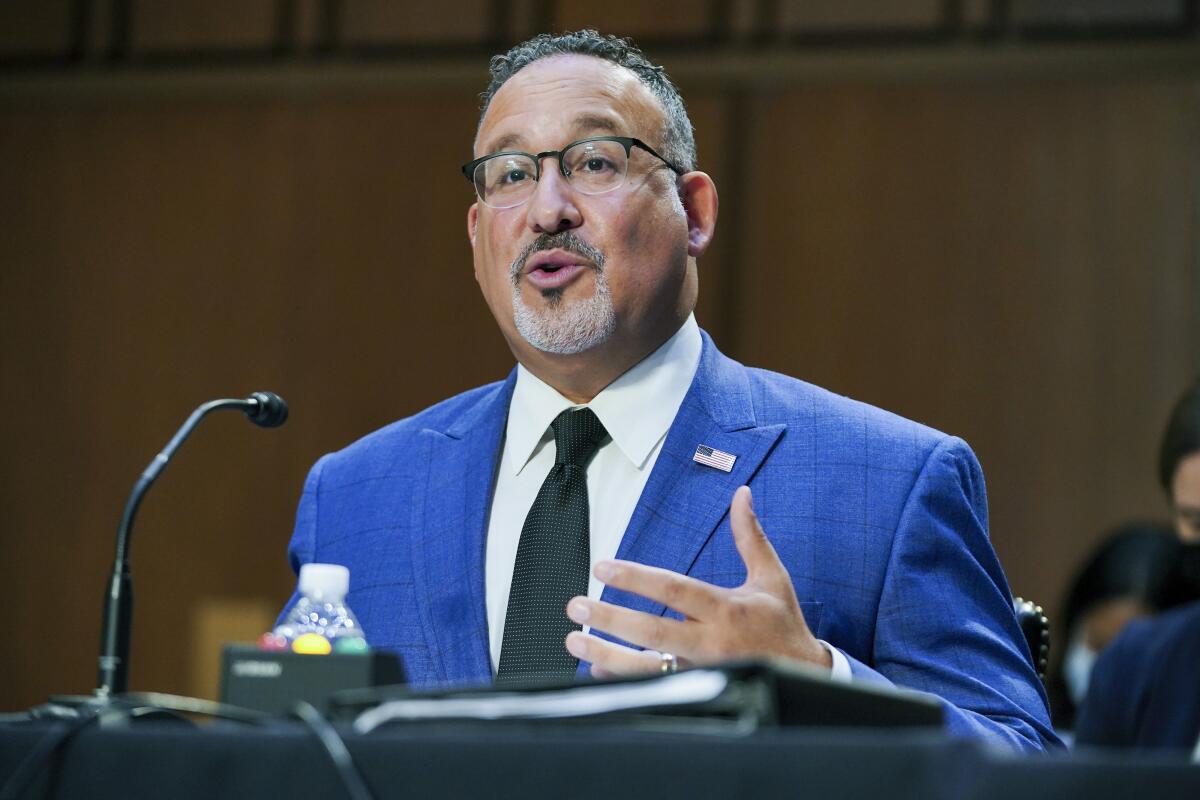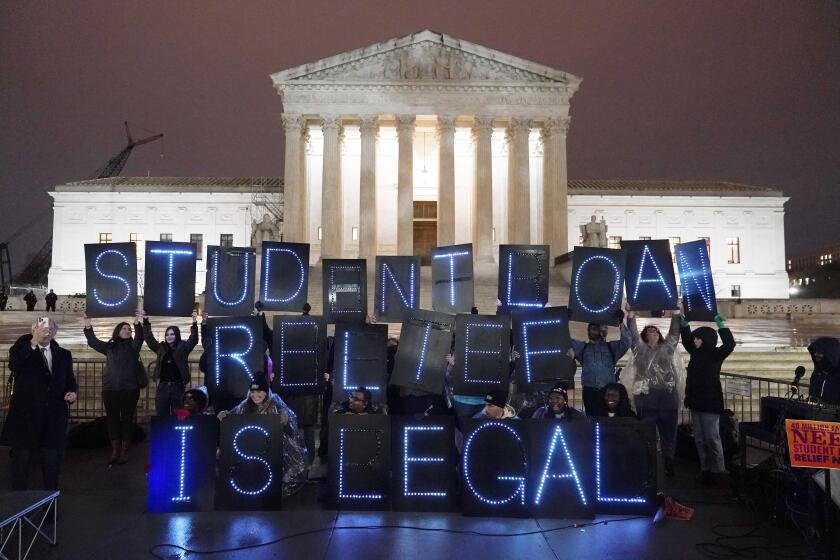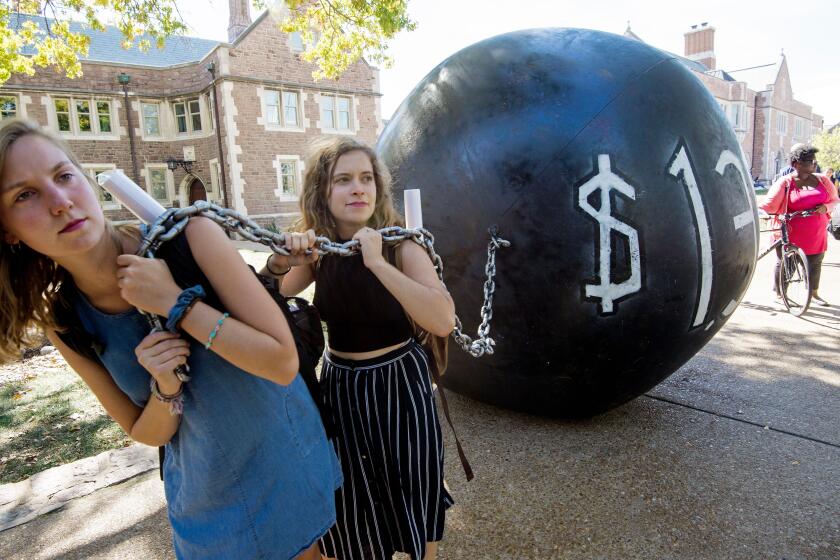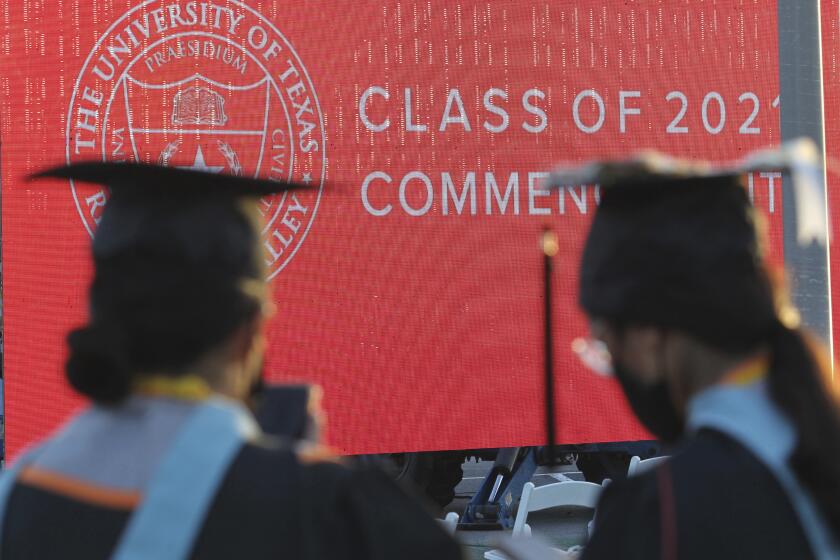More relief for student borrowers could come under new rules

The Biden administration’s plan to wipe out billions of dollars in student loan debt is in legal limbo, blocked at least temporarily by lawsuits. But a related proposal to lower monthly payments for millions of borrowers is taking a major step forward this week.
The U.S. Department of Education laid out a proposed rule Tuesday to simplify and expand eligibility for its income-driven repayment programs, which tie monthly payments on federal student loans to the borrower’s ability to pay. New borrowers would benefit most from the changes; the administration estimated that future borrowers would see their total payments cut by 40% on average. For Black, Latino, American Indian and Alaska Native borrowers, the administration said, the changes would cut their total payments in half.
The administration projected that proposed changes would disproportionately benefit lower-income borrowers. Lifetime payments per dollar borrowed would fall by 83% on average for borrowers in the bottom 30% of earnings, while the top 30% of earners would save just 5%, the administration said.
Critics of the proposal, which carries an estimated price tag of $138 billion over 10 years, say it’s the wrong fix. Maya Macguineas, president of the deficit-minded Committee for a Responsible Federal Budget, said it would encourage more borrowing and higher college costs, while helping “highly educated households who will be — or already are — near the top of the income spectrum.”
Meanwhile, some of those who welcomed the extra relief criticized the proposal for excluding loans taken out by parents and graduate students. “It ignores the reality that low-income families — especially low-income families of color — are more likely to rely on ParentPLUS loans or need to get a graduate degree to earn the same salary as their wealthier white peers,” said Persis Yu, deputy executive director of the Student Borrower Protection Center.
The Education Department expects to publish the proposed rule Wednesday, then field public comments before finalizing the rule later this year. It’s also working on a separate set of rules to help students identify the colleges and certification programs that leave enrollees buried under large amounts of debt without the job skills needed to dig themselves out.
The federal government plans to forgive up to $20,000 in student loan debt for millions of Americans. Here’s everything you need to know.
What changes are proposed for loan repayment?
As part of the proposal, the Education Department would make the modified Revised Pay as You Earn plan the main income-driven plan, phasing out the Income-Contingent Repayment and Pay As You Earn programs for new borrowers. The point, the department says, is to eliminate some of the complexity that deters people from enrolling.
Income-driven repayment plans help borrowers by capping their monthly payments at 10% to 20% of their discretionary income, which is defined as earnings above 150% of the federal poverty level. For a single individual, discretionary earnings start at around $20,400, the department said.
Any unpaid balance will be erased after the number of payments required by each plan. For example, in the REPAYE plan, borrowers who took out loans as undergrads will qualify for loan forgiveness after 20 years’ worth of payments, or 25 years for graduate-school loans. Under the Income-Contingent Repayment plan, it’s 25 years’ worth of payments for all borrowers.
The proposed rule would also make REPAYE significantly more generous to undergraduate student borrowers. A borrower’s total payments could be lowered in three ways:
- Reducing monthly payments to 5% of a borrower’s discretionary income.
- Reducing the amount of income classified as discretionary, further lowering payments. Instead of earnings over 150% of the poverty line, discretionary income would start at 225% of the poverty line.
- Providing loan forgiveness sooner for students who borrowed less. Under the proposal, students who borrowed no more than $12,000 would be eligible for forgiveness after making the equivalent of 10 years of payments. For each additional $1,000 borrowed, the time to forgiveness would be extended by one year’s worth of payments.
According to the department, raising the level of income considered non-discretionary will translate into more borrowers paying $0 per month under the REPAYE plan. That includes individuals earning less than about $30,600 per year and borrowers in a family of four earning less than about $62,400.
In addition, the department wants to stop interest from piling up on borrowers who are complying with their repayment plans. Under the current program, the amount owed by borrowers who stay current on their payments will still grow if those payments aren’t large enough to cover the interest charges. As many as 70% of the borrowers in income-driven repayment programs have seen their balances grow because of this issue, the department said.
Finally, the proposal calls for automatically enrolling borrowers who are at least 2½ months behind in their payments into an income-driven repayment plan with the lowest monthly payment. Borrowers who are in default would also be given access to an income-driven plan.
Just say no to anyone offering to help you obtain the $10,000 to $20,000 in student loan debt forgiveness. You don’t need them.
Who would be helped?
The proposed changes would apply only to undergraduate students’ loans enrolled in REPAYE, not graduate student borrowing. According to the department, borrowers with both types of loans would pay between 5% and 10% of their discretionary income, based on how much they borrowed for each level.
Parents who took out PLUS loans for their children would also be excluded. Parents are eligible today for the ICR plan if they consolidate their borrowing into a federal direct loan, but they’re not eligible for the REPAYE program.
Additionally, REPAYE applies only to federal student loans. Borrowers who took out Perkins and Federal Family Education Loan program loans can enroll in REPAYE if they consolidate their loans into a federal direct consolidated loan, but only if they don’t include any PLUS loans to parents in the package.
A federal judge threw out Biden’s student loan forgiveness program. The Education Department plans to appeal, but the program is on hold in the meantime.
Where does the one-time loan forgiveness stand?
The U.S. Supreme Court is scheduled on Feb. 28 to consider the administration’s appeal of two court rulings that put the debt relief it proposed in August on hold. At issue is whether the department had the legal authority to forgive so much debt in one fell swoop.
The administration argues that the 2003 HEROES Act empowers the department to change repayment rules dramatically during federal emergencies, such as the COVID-19 pandemic. Its opponents, led by Republican state officials, argue that the department is misreading a law that was passed to help National Guard members and military reservists called up after the 9/11 terrorist attacks.
The justices agreed to hear the case on an accelerated timetable, so a decision may come well before the high court typically wraps up for the year in late June.
Rep. Eric Swalwell of the Bay Area has spent years pushing legislation to forgive student loan interest and set rates to zero.
What else is being proposed?
The department also plans to come up with a way to identify the “lowest financial value” colleges and training programs. This would take the form of a list of institutions that deliver the lowest educational bang for the buck — places that charge high prices, but don’t leave students with a corresponding level of skill.
At this point, though, it’s still figuring out how to do that. The department plans to put out a call for information Wednesday, inviting the public to suggest ways to determine which programs are producing the least amount of value.
The list would ultimately be used to warn students before they enroll and take out loans about the programs that could leave them swamped with debt. It’s one piece of the department’s effort to increase accountability among the institutions whose tuitions are paid by federal student loans.
Other parts of this effort include adopting a new “gainful employment” rule to require training programs to successfully place students into jobs in order to be eligible for federal aid, and strengthening protections against taxpayers being stuck with the bill for unpaid student loans when colleges fail or are shut down.
About The Times Utility Journalism Team
This article is from The Times’ Utility Journalism Team. Our mission is to be essential to the lives of Southern Californians by publishing information that solves problems, answers questions and helps with decision making. We serve audiences in and around Los Angeles — including current Times subscribers and diverse communities that haven’t historically had their needs met by our coverage.
How can we be useful to you and your community? Email utility (at) latimes.com or one of our journalists: Jon Healey, Ada Tseng, Jessica Roy and Karen Garcia.
More to Read
Totally Worth It
Be your money's boss! Learn how to make a budget and take control of your finances with this eight-week newsletter course.
You may occasionally receive promotional content from the Los Angeles Times.















